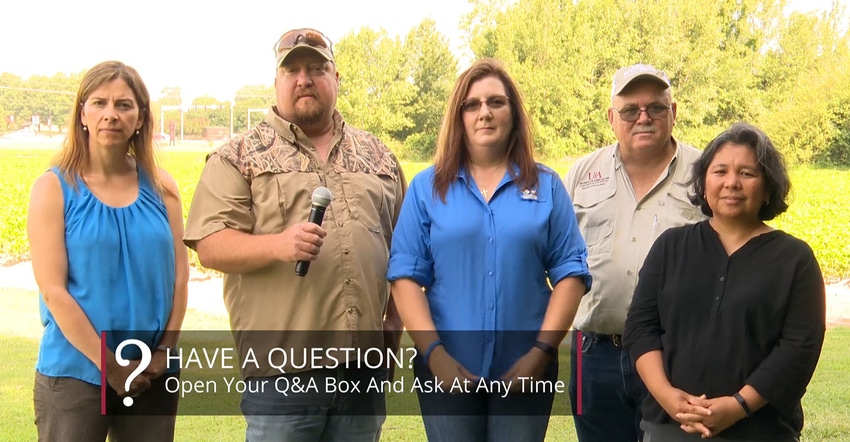July 23, 2019

Soil moisture sensors could be the next step in helping you get more return on your investment in the irrigation water that’s available on your farm.
Many Mid-South producers have begun using computerized hole selection or Pipe Planner or PHAUCET software to more evenly spread irrigation water on their fields. But Mike Hamilton says farmers may need to do more to improve irrigation efficiency.
“An 80-bushel soybean crop will use more water than a 40-bushel crop,” says Hamilton, an irrigation specialist with the University of Arkansas System Division of Agriculture. “Moisture sensors will tell you how much water your crop is using.”
Hamilton was one of the speakers for the “Technology Assisting Farmers with Irrigation Scheduling Practices Conservation Virtual Field Tour,” a webinar sponsored by the University of Arkansas Cooperative Extension Service, Arkansas State University and USDA’s Natural Resources Conservation Service. (To view the video visit https://youtu.be/rG902Z95GKc.
The setting for the virtual field tour was the historic Judd Hill Farm near Truman, Ark. The farm is operated by the Judd Hill Foundation and Arkansas State University through its College of Agriculture and Technology.
“We have a lot of producers who are implementing irrigation water management practices, such as computerized hole selection software,” said Hamilton, who works with the University of Arkansas Cooperative Extension Service in Truman. “Our thanks to Delta Plastics and the H20 initiative for letting us use that program.
Pipe Planner, PHAUCET
“We are using Pipe Planner and PHAUCET software (the latter developed by USDA’s NRCS) to get water to the end of furrow efficiently. We are designing the system so each furrow is getting the correct amount of water independent of the length of the furrow.”
Why should farmers consider using soil moisture sensors? “These soil moisture sensors will actually do something that nothing else will do in the field — it will measure how much water your crop is using,” says Hamilton.
“All of the other irrigation scheduling programs or techniques use an average of how much water the plant is using during different growth stages. The soil moisture sensors tell you the depths that your plant is using water and how much your crop is using.”
Hamilton said University of Arkansas researchers have been placing Watermark soil moisture sensors in their soils for more than 40 years. They typically place the sensors at the 6-, 12-, 18- and 30-inch soil depths to determine how much water is being used at those different levels.
“Once we put these out in the field, we’ll want to weight them depending on the depth that plant is showing us that we have water use,” said Hamilton. “If my graph is showing me the sensors are moving at 6 and 12 inches, then I know that I am using water at 12 inches so I will weight it accordingly.
“I will do 50 percent for the 6-inch and 50 percent of my weight for the 12‑inch sensor. If I see the indicator for the 18‑inch sensor is starting to move on me, then I know that my roots are getting down to 18 inches, and I will weight it accordingly.”
Hamilton says he gives 33 percent of the weight in the top 6 inches, 33 percent in the 12-inch and 33 percent in that 18-inch sensor. “That represents all of the depth of my roots at that time. If all my sensors (6, 12, 18 and 30) are moving, my— and this happens more often than you think — we will give a third of the weight to the first foot; that is 17 percent for 6 inches and 17 percent for 12.
“Then we will do 33 percent for the 18‑inch sensor and then we will do 33 percent for the 30‑inch sensor. That represents a third in each foot of soil that we have in our soil profile, and it represents the depths of the roots.”
How to use numbers
How should farmers use those numbers? “We want to use how much water is available in there, and, in the 40 years we have been looking at Watermark sensors we have a good idea of what 60 centibars, 70 centibars, 80 centibars mean,” says Hamilton.
“In general, we’ll trigger irrigations from 50 to 80 centibars, but it depends on a lot of factors, including the crop we’re growing and the growth stage of that crop. In early season, we don't use as much water as when we get to mid-season. When we tail off at the end, we start going down.”
Soil types are also a consideration since a sandier soil doesn't have as much water-holding capabilities as a silt loam soil, he noted.
Soil moisture sensors should be conditioned before they are placed in the soil. “Soak them in water and then allow them to dry over a couple of days,” he said. “Get them used to going wet and dry so we can see that movement in there.
“We want to put a wet probe into a dry hole when we install them in the field. We like to use a slide hammer because the slide hammer is basically the same diameter as the Watermark sensor that we are using. We try not to disturb the soil profile when we install them so we can get good soil-to-sensor contact.”
Place the soil moisture sensors about halfway to two‑thirds of the way down the furrow in a representative part of the field; that is, in a location where the soil type mirrors more of the predominant soil type.
“The wettest part of the field is generally at the top where the irrigation pipe is pouring water into the furrows or at the bottom where water will back up occasionally,” he said. “We want to put it in a drier spot of the field so we get water to the plants that are stressing first.”
To learn more about soil moisture sensors, contact your county Extension or local NRCS office, Hamilton said.
About the Author(s)
You May Also Like






